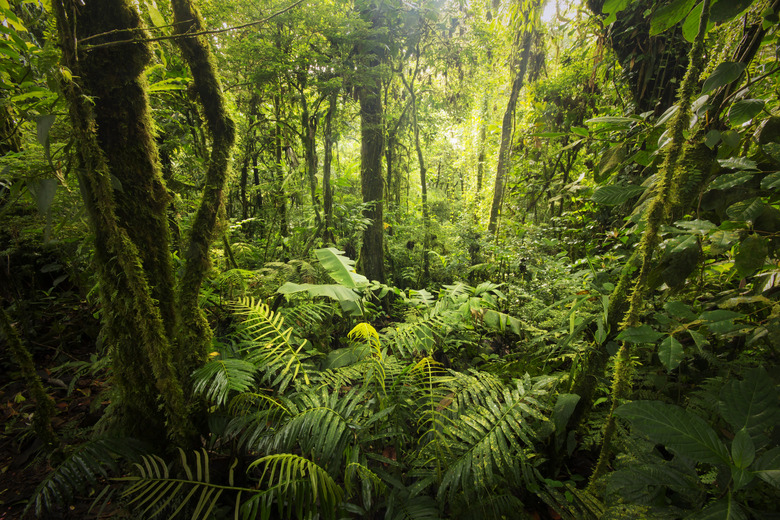Facts About Understory Layer Of The Rainforest
A rain forest can be split up into three main layers. At the very top, the canopy supports the greatest density of life, from palm trees to brightly colored parrots. At the bottom is the forest floor, which receives little sunshine. Between those two is the understory layer, which features an ecosystem that rivals the other layers.
Understory Habitat
Understory Habitat
Rainforests receive at least 100 inches of rain each year. Whether tropical or temperate, canopy trees can extend 40 feet, with branches growing only near the tree tops in order to receive as much sunlight as possible. Because of the thick canopy layer, the understory is relatively dim and dark. The air is still, and only a stronger gust of wind ripples through. And if you stood among understory trees during a rainstorm, it would take some time before you felt the first few raindrops. The canopy layer blocks much of that 100 inches of rain, despite rainforests' frequent and heavy downpours.
Understory Plants
Understory Plants
Understory plants have evolved to live with less sunlight and fewer nutrients than their canopy counterparts. They grow larger, wider leaves to catch any sunlight or water that trickles down. The flowers are smaller and paler and do not always grow at the end of a plant's branches. Instead, in order to aid pollination, plants may grow their flowers on their stem or trunk to attract greater attention. Many of the flowers, like ginger and passionflowers, are very brightly colored. These adaptations come down even to smell: "Flowers pollinated by hawkmoths, for example, have a heavy, sweet fragrance, while those pollinated by bats have a meaty, sweaty odor," the Smithsonian Tropical Research Institute says. Many plants, like orchids and bromeliads, are epiphytes, drawing their water and nutrients from the air.
Understory Animals
Understory Animals
Like plants, many understory animals have special adaptations in order to live there. Take the jaguar, for instance. The jaguar spends a large portion of its life in understory branches, waiting and watching for prey to pass on the forest floor below, and to climb with ease, the jaguar has chest, shoulder and back muscles to rival any other big cat. The jaguar's color camouflages this big predator. Or look at the tree frog, which uses suction cup-like toes to travel through the understory's dark, damp and humid environment as the canopy-dweller migrates vertically to lay eggs where the tadpoles can fall into ponds on the forest floor. Insects, including mosquitos, form a large part of the population of the understory. Amphibians thrive in the hot and humid environment.
Lichen and Moss
Lichen and Moss
Plants and tree trunks in the understory may have a pale-blue or a sea-green patch on them. Lichens feel like a fish's scales, or perhaps slimy or rough, if you ran your hand over it. Lichens share a symbiotic relationship with their host, working as nitrogen fixers while receiving the necessary photosynthetic materials to live. Mosses also pull moisture and nutrients from the air.
Cite This Article
MLA
Brown, Abram. "Facts About Understory Layer Of The Rainforest" sciencing.com, https://www.sciencing.com/understory-layer-rainforest-8483114/. 22 November 2019.
APA
Brown, Abram. (2019, November 22). Facts About Understory Layer Of The Rainforest. sciencing.com. Retrieved from https://www.sciencing.com/understory-layer-rainforest-8483114/
Chicago
Brown, Abram. Facts About Understory Layer Of The Rainforest last modified March 24, 2022. https://www.sciencing.com/understory-layer-rainforest-8483114/
